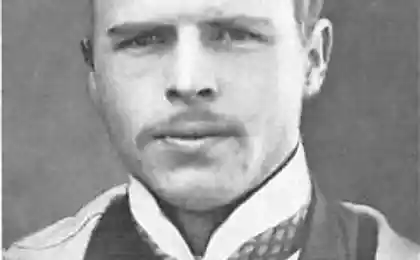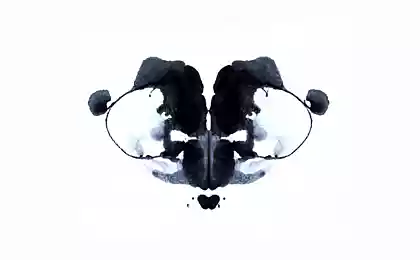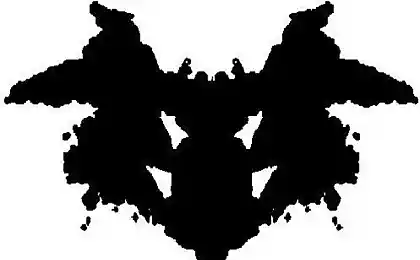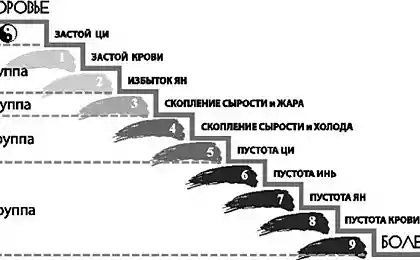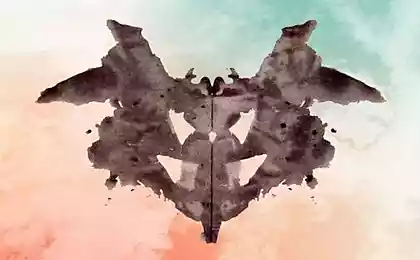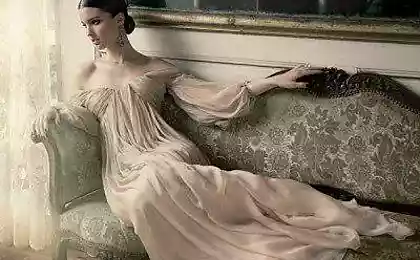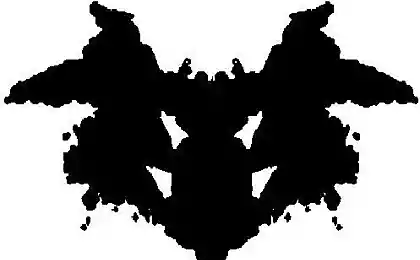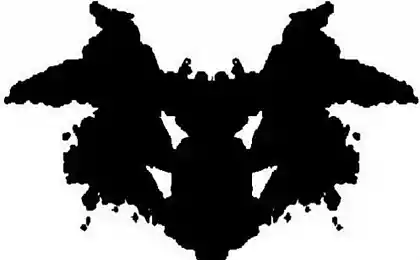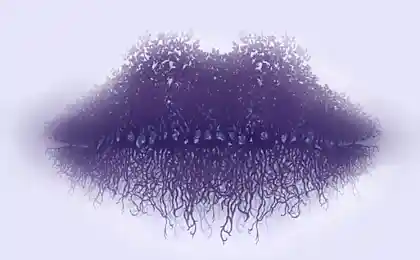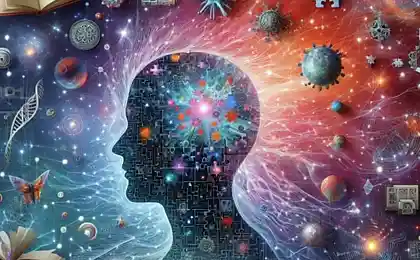759
10 ink spots: how does Rorschach test
Herman Rorschach was born on 8 November 1884 in Zurich (Switzerland). He was the eldest son of the unfortunate artist who had to earn a living by drawing lessons in school. Herman from childhood was fascinated by the color spot (in all likelihood, the result of the creative efforts of his father and his own love of the boy to painting), and school friends nicknamed him Smudge.
When Herman was twelve, his mother died, and when the boy was eighteen, he died, and the father. Having graduated with honours from high school, Rorschach decided to study medicine. In 1912 he received the degree of doctor of medicine at Zurich University, then worked in several mental hospitals.
Forty one million nine hundred twenty four thousand four hundred twenty seven
In 1911, while still a student at the University, Rorschach had a number of interesting experiments to test whether the different artistic talents of the gifted students are more imaginative in the interpretation of ordinary ink stains. This study has had an enormous influence not only to further his academic career, but also on the development of psychology as a science in General.
I must say, Rorschach was not the first to use in his studies of colour, but in his experiment the first time they were used in the analytical approach. Pthe results of the first experiment the scientist was lost, but over the next ten years, Rorschach conducted a large-scale study that developed a systematic methodology that allows psychologists to identify the personality types of people using a conventional ink spots. Thanks to the work in a psychiatric hospital had free access to her patients. Thus, Rorschach conducted a study of how the mentally ill and emotionally healthy, which allowed him to develop a systematic test application of ink stains, which can be used to analyze personal characteristics of the person, to determine his personality type and, if necessary, correct it.
In 1921, Rorschach introduced the results of his large-scale labor world, published a book called "Psycho". In it the author outlined his theory about the personal characteristics of the people.
One of the main provisions is that in the personality of each individual is represented by qualities such as introversion and extraversion — in other words, what motivate us, both external and internal factors. According to the scientist, the test ink spots allows to assess the relative ratio of these properties and to identify any mental disorder or, conversely, the strengths of the individual. The psychological scientific community almost did not pay attention to the first edition of Rorschach, because in those days was dominated by the view that it is impossible either to measure or to test what is the identity of the person.
However, over time, colleagues began to understand the benefits of Rorschach test, and in 1922, the psychiatrist discussed the possibility of the improvement of his method at a meeting of the Psychoanalytic society. Unfortunately, on April 1, 1922, after a week severe pains in the abdomen, Hermann Rorschach was in the hospital with suspected appendicitis, and on April 2 died of peritonitis. He was only thirty-seven years, and he never saw the huge success of invented psychological tool.
Ink blots RorschachA Rorschach test uses ten ink spots: five black-and-white, two black and red and three colored. The psychologist shows the cards in strict order of asking the patient the same question: "what is it like?". After the patient saw all the pictures and give the answers, the psychologist shows the card again, again in strict order. The patient is asked to name all that he sees, exactly where pictures he sees one or another way and that it makes him give this answer.
Flashcards you can flip, skew, manipulate in any other way. A psychologist shall accurately record everything the patient says and does during the test and the time each response. Then the answers are analyzed and calculated points. Then by mathematical calculation displays the result according to the test, which is interpreted by a specialist.
If any ink stain does not cause any associations or he can't describe what it sees, it may indicate that the picture object in his mind is blocked, or that the image is associated in his subconscious with the topic at the moment, he did not wish to discuss.
Card 1 Forty three million thirty one thousand five hundred fifty one
On the first card we see a spot of black ink. It shows first, it allows the psychologist to imagine how this person performs a new task — hence related to a specific stress. Usually people say that the picture reminds them of bat, moth, butterfly, or face of an animal, e.g. an elephant or a rabbit. The answer displays the type of an individual's personality as a whole.
For some people the image of a bat is associated with something unpleasant and even demonic; for others it is a symbol of rebirth and the ability to navigate in the dark. Butterflies can symbolize transition and transformation, as well as the ability to grow, to change, to overcome difficulties. The moth symbolizes the feelings of abandonment and ugliness and weakness and anxiety.
The animal's face, in particular the elephant often symbolizes the ways in which we confront the difficulties, and fear of internal problems. It can also mean "elephant in a China shop", that is, to convey a sense of discomfort, and point to a certain problem, which people at the moment trying to get rid of.
Card 2 Eight million two hundred eighty five thousand two hundred forty four
This card shows a spot of red-black color, and people often see it as something sexual. The red color is usually interpreted as blood, and the reaction to it shows how a person manages their feelings and anger and how to cope with the physical damage. Respondents most often say that this spot reminds them of the act of supplication, two people, a man looking in the mirror, or some long-legged animal such as a dog, bear or elephant.
If a person sees the spot of two people, it can symbolize the interdependence, the obsession with sex, the ambivalent attitude to the sexual contact or focus on communication and close relationships with others. If the stain resembles reflected in the mirror of a person, it can symbolize egocentricity or, conversely, a tendency to self-criticism.
In each of the two variants are expressed, or the negative or positive characteristics of the individual, depending on what feelings the image evokes in humans. If the Respondent sees in the spot the dog, it may mean that he is a loyal and loving friend. If he takes the spot as something negative — so he must face to face with their fears and admit their feelings.
If the stain reminds the person of the elephant, it can symbolize a tendency to thought, intelligence and a good memory; sometimes, however, this vision speaks of a negative perception of their own body.
The bear, captured in the spot, symbolizes aggression, competition, independence, disobedience. In the case of English-speaking patients can play a role of bear (bear) and bare (bare), which means a sense of insecurity, vulnerability, and sincerity and honesty of the respondents.
Spot on this card reminds you of something sexual, and if the Respondent sees it as a praying person, this may indicate that the attitude towards sex in the context of religion. If this meeting sees the spot of blood — so he is associating religion physical pain or experiencing difficult emotions like anger, resorted to prayer, or is associating anger with religion.
Card 3 Sixty four million six hundred thirty eight thousand three hundred ten
The third card shows a spot of red and black ink, and it symbolizes the perception of the patient's relationship to others within social interaction. Most of the respondents see the image of two people looking in the mirror of a person, a butterfly or moth.
If a person sees the spot of two dinner people — that means he has an active social life. Spot, reminiscent of two people, washing hands, talking about insecurity, the feeling of impurity or paranoid fear. If the Respondent saw the blur of two people playing some kind of game, it often indicates that he is in social interactions the position of your opponent. If the stain is like a man looking at his reflection in the mirror, this may indicate egocentricity, inattention to others and inability to understand people.
Card 4 Sixty three million six hundred seventy nine thousand four hundred twenty three
The fourth card is called "father". Stain it black, and some parts are fuzzy, blurry. Many see in this picture something big and frightening image which is usually not perceived as female and as male. The reaction to this stain allows to identify the relation of man to authority, and especially his education. Most often, the spot reminds the respondents of a huge animal or a monster or the burrow of some animal or his skin.
If the patient sees the spot a big animal or monster, it could symbolize a feeling of inferiority and admiration for the authorities, as well as an exaggerated fear of people in positions of power, including his own father. If the stain is reminiscent of meet the animal's skin, it often symbolizes a severe internal discomfort in discussing topics related to the father. However, this may indicate that the problem of inferiority or worship of authority for the Respondent is irrelevant.
Card 5 Nineteen million three hundred forty four thousand six hundred fifty five
On this card we can see again a black spot. Association, due to them, as the image on the first card reflects our true self. Looking at this image, people usually do not feel threatened, and because previous cards, they have caused very different emotions, this time people do not feel any stress or discomfort, hence, will be characterized by a deeply personal reaction. If the seen image is very different from the answer given at the first card, this means that cards from the second to the fourth, most likely, made a big impression on him. Most often, this image reminds people of a bat, butterfly or moth.
Card 6 Forty five million nine hundred sixty nine thousand two hundred ten
The picture on the card is also plain black; it is distinguished by the texture of the spots. This image makes the person Association between interpersonal closeness, so it is called the "sexy card". Most people say it reminds them of the hole or hide of an animal that may indicate a reluctance to engage in intimate relationships with other people and, as a consequence, the feeling of inner emptiness and isolation from society.
Card 7 Sixty million fifty seven thousand six hundred sixty five
The stain on this card is also black, and it is usually associated with the feminine. Because people often see this as the spot images of women and children, it is called "parent". If a person experiences difficulty with the description of the image on the card — it might indicate that he formed a complicated relationship with women. Respondents often say that spot is reminiscent of their heads or faces of women or children; it can also arouse memories of the kiss.
If the stain seems like the heads of women, it symbolizes the feeling associated with the mother responding that have an impact on his attitude towards the female sex in General. If the stain is reminiscent of the children's heads, it symbolizes the feelings associated with childhood and the need to care for the child who lives in the soul of the Respondent, or that the relationship of the patient with the mother, need attention and possible correction. If a person sees in the spot, the two heads leaning in for a kiss, it speaks to his desire to be loved and to reunite with his mother or that he seeks to reproduce the once-close relationship with mother into other relationships, including romantic or social.
Card 8 Seventy one million two hundred twenty three thousand two hundred sixty one
On this card there are gray, pink, and orange, and blue. It is not only the first multicolored card in the test, it is also particularly difficult to interpret. If it is in its display or change the rate of display of images Respondent feels uncomfortable with — it is highly likely that in the life he has difficulty processing complex situations or emotional stimuli. Most people say they see here a four-legged animal, a butterfly or moth.
Card 9 Eight million five hundred twenty nine thousand nine hundred forty eight
Spot on this card include green, pink and orange. It has an indefinite outline, so most people find it difficult to understand that it resembles this image. For this reason, this card allows you to evaluate how well people cope with the lack of a clear structure and uncertainty. Patients often see a General outline of a man, or a kind of indefinite form of evil.
If the Respondent sees a man, we experience the feeling passed, how well he copes with the lack of organization of time and information. If the spot resembles an abstract image of evil, this may indicate that the feeling of comfort a person need to have his life had a clear schedule, and that he does not cope with uncertainty.
Card 10 Seven million two hundred forty four thousand nine hundred sixty seven
The last card of Rorschach test the most flowers: there are orange and yellow and green and pink, and grey, and blue. In form it is somewhat similar to the eighth card, but the complexity is more in line with the ninth.
Many people experience quite pleasant feelings at the sight of this card, except those who were very puzzled by the difficulty of defining the image depicted in the previous card; when I look at this picture they feel the same way. This may indicate that they find it difficult to cope with a similar, simultaneous or overlapping incentives. Most people see this card crab, lobster, spider, rabbit head, snakes or caterpillars.
The image of the crab symbolizes the tendency of the Respondent too much to become attached to things and people or is the quality of tolerance. If a person sees the picture of the lobster, it can talk about his strength, tolerance and ability to cope with minor problems and the fear to hurt yourself or suffer damage from someone else. If a spot is reminiscent of a spider, it can be a symbol of fear, of feeling that person by force or fraud were drawn into a difficult situation. Also, the spider symbolizes the overly protective and caring mother, and a woman's power.
If a person sees the head of a rabbit, it could symbolize the reproductive ability and positive attitude to life. Snakes represent a sense of danger or the feeling that the man was deceived, and fear of the unknown. Snakes are also often regarded as a phallic symbol and associated with unacceptable or forbidden sexual desires. Since this is the last card in the test, if the patient sees her larvae, it says about the prospects of growth and understanding that people are ever changing and evolving.published
Also interesting: the Hit parade of questions to a psychologist
Scenarios of the fate and role options in this world for everyone
P. S. And remember, just changing your mind — together we change the world! ©
Source: www.factroom.ru/psychology/rorschach-test
When Herman was twelve, his mother died, and when the boy was eighteen, he died, and the father. Having graduated with honours from high school, Rorschach decided to study medicine. In 1912 he received the degree of doctor of medicine at Zurich University, then worked in several mental hospitals.
Forty one million nine hundred twenty four thousand four hundred twenty seven
In 1911, while still a student at the University, Rorschach had a number of interesting experiments to test whether the different artistic talents of the gifted students are more imaginative in the interpretation of ordinary ink stains. This study has had an enormous influence not only to further his academic career, but also on the development of psychology as a science in General.
I must say, Rorschach was not the first to use in his studies of colour, but in his experiment the first time they were used in the analytical approach. Pthe results of the first experiment the scientist was lost, but over the next ten years, Rorschach conducted a large-scale study that developed a systematic methodology that allows psychologists to identify the personality types of people using a conventional ink spots. Thanks to the work in a psychiatric hospital had free access to her patients. Thus, Rorschach conducted a study of how the mentally ill and emotionally healthy, which allowed him to develop a systematic test application of ink stains, which can be used to analyze personal characteristics of the person, to determine his personality type and, if necessary, correct it.
In 1921, Rorschach introduced the results of his large-scale labor world, published a book called "Psycho". In it the author outlined his theory about the personal characteristics of the people.
One of the main provisions is that in the personality of each individual is represented by qualities such as introversion and extraversion — in other words, what motivate us, both external and internal factors. According to the scientist, the test ink spots allows to assess the relative ratio of these properties and to identify any mental disorder or, conversely, the strengths of the individual. The psychological scientific community almost did not pay attention to the first edition of Rorschach, because in those days was dominated by the view that it is impossible either to measure or to test what is the identity of the person.
However, over time, colleagues began to understand the benefits of Rorschach test, and in 1922, the psychiatrist discussed the possibility of the improvement of his method at a meeting of the Psychoanalytic society. Unfortunately, on April 1, 1922, after a week severe pains in the abdomen, Hermann Rorschach was in the hospital with suspected appendicitis, and on April 2 died of peritonitis. He was only thirty-seven years, and he never saw the huge success of invented psychological tool.
Ink blots RorschachA Rorschach test uses ten ink spots: five black-and-white, two black and red and three colored. The psychologist shows the cards in strict order of asking the patient the same question: "what is it like?". After the patient saw all the pictures and give the answers, the psychologist shows the card again, again in strict order. The patient is asked to name all that he sees, exactly where pictures he sees one or another way and that it makes him give this answer.
Flashcards you can flip, skew, manipulate in any other way. A psychologist shall accurately record everything the patient says and does during the test and the time each response. Then the answers are analyzed and calculated points. Then by mathematical calculation displays the result according to the test, which is interpreted by a specialist.
If any ink stain does not cause any associations or he can't describe what it sees, it may indicate that the picture object in his mind is blocked, or that the image is associated in his subconscious with the topic at the moment, he did not wish to discuss.
Card 1 Forty three million thirty one thousand five hundred fifty one
On the first card we see a spot of black ink. It shows first, it allows the psychologist to imagine how this person performs a new task — hence related to a specific stress. Usually people say that the picture reminds them of bat, moth, butterfly, or face of an animal, e.g. an elephant or a rabbit. The answer displays the type of an individual's personality as a whole.
For some people the image of a bat is associated with something unpleasant and even demonic; for others it is a symbol of rebirth and the ability to navigate in the dark. Butterflies can symbolize transition and transformation, as well as the ability to grow, to change, to overcome difficulties. The moth symbolizes the feelings of abandonment and ugliness and weakness and anxiety.
The animal's face, in particular the elephant often symbolizes the ways in which we confront the difficulties, and fear of internal problems. It can also mean "elephant in a China shop", that is, to convey a sense of discomfort, and point to a certain problem, which people at the moment trying to get rid of.
Card 2 Eight million two hundred eighty five thousand two hundred forty four
This card shows a spot of red-black color, and people often see it as something sexual. The red color is usually interpreted as blood, and the reaction to it shows how a person manages their feelings and anger and how to cope with the physical damage. Respondents most often say that this spot reminds them of the act of supplication, two people, a man looking in the mirror, or some long-legged animal such as a dog, bear or elephant.
If a person sees the spot of two people, it can symbolize the interdependence, the obsession with sex, the ambivalent attitude to the sexual contact or focus on communication and close relationships with others. If the stain resembles reflected in the mirror of a person, it can symbolize egocentricity or, conversely, a tendency to self-criticism.
In each of the two variants are expressed, or the negative or positive characteristics of the individual, depending on what feelings the image evokes in humans. If the Respondent sees in the spot the dog, it may mean that he is a loyal and loving friend. If he takes the spot as something negative — so he must face to face with their fears and admit their feelings.
If the stain reminds the person of the elephant, it can symbolize a tendency to thought, intelligence and a good memory; sometimes, however, this vision speaks of a negative perception of their own body.
The bear, captured in the spot, symbolizes aggression, competition, independence, disobedience. In the case of English-speaking patients can play a role of bear (bear) and bare (bare), which means a sense of insecurity, vulnerability, and sincerity and honesty of the respondents.
Spot on this card reminds you of something sexual, and if the Respondent sees it as a praying person, this may indicate that the attitude towards sex in the context of religion. If this meeting sees the spot of blood — so he is associating religion physical pain or experiencing difficult emotions like anger, resorted to prayer, or is associating anger with religion.
Card 3 Sixty four million six hundred thirty eight thousand three hundred ten
The third card shows a spot of red and black ink, and it symbolizes the perception of the patient's relationship to others within social interaction. Most of the respondents see the image of two people looking in the mirror of a person, a butterfly or moth.
If a person sees the spot of two dinner people — that means he has an active social life. Spot, reminiscent of two people, washing hands, talking about insecurity, the feeling of impurity or paranoid fear. If the Respondent saw the blur of two people playing some kind of game, it often indicates that he is in social interactions the position of your opponent. If the stain is like a man looking at his reflection in the mirror, this may indicate egocentricity, inattention to others and inability to understand people.
Card 4 Sixty three million six hundred seventy nine thousand four hundred twenty three
The fourth card is called "father". Stain it black, and some parts are fuzzy, blurry. Many see in this picture something big and frightening image which is usually not perceived as female and as male. The reaction to this stain allows to identify the relation of man to authority, and especially his education. Most often, the spot reminds the respondents of a huge animal or a monster or the burrow of some animal or his skin.
If the patient sees the spot a big animal or monster, it could symbolize a feeling of inferiority and admiration for the authorities, as well as an exaggerated fear of people in positions of power, including his own father. If the stain is reminiscent of meet the animal's skin, it often symbolizes a severe internal discomfort in discussing topics related to the father. However, this may indicate that the problem of inferiority or worship of authority for the Respondent is irrelevant.
Card 5 Nineteen million three hundred forty four thousand six hundred fifty five
On this card we can see again a black spot. Association, due to them, as the image on the first card reflects our true self. Looking at this image, people usually do not feel threatened, and because previous cards, they have caused very different emotions, this time people do not feel any stress or discomfort, hence, will be characterized by a deeply personal reaction. If the seen image is very different from the answer given at the first card, this means that cards from the second to the fourth, most likely, made a big impression on him. Most often, this image reminds people of a bat, butterfly or moth.
Card 6 Forty five million nine hundred sixty nine thousand two hundred ten
The picture on the card is also plain black; it is distinguished by the texture of the spots. This image makes the person Association between interpersonal closeness, so it is called the "sexy card". Most people say it reminds them of the hole or hide of an animal that may indicate a reluctance to engage in intimate relationships with other people and, as a consequence, the feeling of inner emptiness and isolation from society.
Card 7 Sixty million fifty seven thousand six hundred sixty five
The stain on this card is also black, and it is usually associated with the feminine. Because people often see this as the spot images of women and children, it is called "parent". If a person experiences difficulty with the description of the image on the card — it might indicate that he formed a complicated relationship with women. Respondents often say that spot is reminiscent of their heads or faces of women or children; it can also arouse memories of the kiss.
If the stain seems like the heads of women, it symbolizes the feeling associated with the mother responding that have an impact on his attitude towards the female sex in General. If the stain is reminiscent of the children's heads, it symbolizes the feelings associated with childhood and the need to care for the child who lives in the soul of the Respondent, or that the relationship of the patient with the mother, need attention and possible correction. If a person sees in the spot, the two heads leaning in for a kiss, it speaks to his desire to be loved and to reunite with his mother or that he seeks to reproduce the once-close relationship with mother into other relationships, including romantic or social.
Card 8 Seventy one million two hundred twenty three thousand two hundred sixty one
On this card there are gray, pink, and orange, and blue. It is not only the first multicolored card in the test, it is also particularly difficult to interpret. If it is in its display or change the rate of display of images Respondent feels uncomfortable with — it is highly likely that in the life he has difficulty processing complex situations or emotional stimuli. Most people say they see here a four-legged animal, a butterfly or moth.
Card 9 Eight million five hundred twenty nine thousand nine hundred forty eight
Spot on this card include green, pink and orange. It has an indefinite outline, so most people find it difficult to understand that it resembles this image. For this reason, this card allows you to evaluate how well people cope with the lack of a clear structure and uncertainty. Patients often see a General outline of a man, or a kind of indefinite form of evil.
If the Respondent sees a man, we experience the feeling passed, how well he copes with the lack of organization of time and information. If the spot resembles an abstract image of evil, this may indicate that the feeling of comfort a person need to have his life had a clear schedule, and that he does not cope with uncertainty.
Card 10 Seven million two hundred forty four thousand nine hundred sixty seven
The last card of Rorschach test the most flowers: there are orange and yellow and green and pink, and grey, and blue. In form it is somewhat similar to the eighth card, but the complexity is more in line with the ninth.
Many people experience quite pleasant feelings at the sight of this card, except those who were very puzzled by the difficulty of defining the image depicted in the previous card; when I look at this picture they feel the same way. This may indicate that they find it difficult to cope with a similar, simultaneous or overlapping incentives. Most people see this card crab, lobster, spider, rabbit head, snakes or caterpillars.
The image of the crab symbolizes the tendency of the Respondent too much to become attached to things and people or is the quality of tolerance. If a person sees the picture of the lobster, it can talk about his strength, tolerance and ability to cope with minor problems and the fear to hurt yourself or suffer damage from someone else. If a spot is reminiscent of a spider, it can be a symbol of fear, of feeling that person by force or fraud were drawn into a difficult situation. Also, the spider symbolizes the overly protective and caring mother, and a woman's power.
If a person sees the head of a rabbit, it could symbolize the reproductive ability and positive attitude to life. Snakes represent a sense of danger or the feeling that the man was deceived, and fear of the unknown. Snakes are also often regarded as a phallic symbol and associated with unacceptable or forbidden sexual desires. Since this is the last card in the test, if the patient sees her larvae, it says about the prospects of growth and understanding that people are ever changing and evolving.published
Also interesting: the Hit parade of questions to a psychologist
Scenarios of the fate and role options in this world for everyone
P. S. And remember, just changing your mind — together we change the world! ©
Source: www.factroom.ru/psychology/rorschach-test
